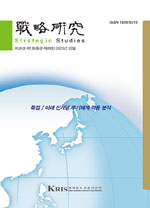- 영문명
- Changes of Party-Military Relation and Management of the Political Organizations of the People's Army in North Korea
- 발행기관
- 한국전략문제연구소
- 저자명
- 유영구
- 간행물 정보
- 『전략연구』통권 제11호, 61~134쪽, 전체 74쪽
- 주제분류
- 사회과학 > 정치외교학
- 파일형태
- 발행일자
- 1997.11.30
11,680원
구매일시로부터 72시간 이내에 다운로드 가능합니다.
이 학술논문 정보는 (주)교보문고와 각 발행기관 사이에 저작물 이용 계약이 체결된 것으로, 교보문고를 통해 제공되고 있습니다.

국문 초록
영문 초록
Historical Changes of Party-Military Relation( 1) :from the Army of the Party to the Army of the Great Leader( Suryong) The Korean People's Army had been set up on Feb. 8, 1948 before the Democratic People's Republic of Korea was established. The Army o주ed a strong political character from its inception. The Army was, from the beginning, the Army of the Party and the Army of revolution aimed at emancipating the southern half of the Korean peninsula. Especially, the Manchurian partisan group under the direct control of Kim Il-sung was absorbed in quantities into the Army. The control on the Army becomes much stronger through the period of the Korean War. While retreating in the Korean War, the Workers' Party of Korea took such measures as setting up of the Military Commission, the expansion of the cultural department into the political department. establishment of the party organs and the general political bureau in the army. Kim Il-sung at the 4th Plenum of the Party Central Committee on November 1. 1951 denounced that Hoe Ga-yi's line of party organization had weakened the party, thus proposing to increase the party membership. The identifica-tion of the military with the party begins with the increased joining of the party members from the front. After the truce treaty in July 1953. Kim Il-sung pursued the nation construction with the Army as its mainstay. while strengthening his party-centered base of power. He went on to beef up the military despite the severe economic difficulties in the period of reconstruction after the Korean War, thus further promoting the identification of the military with the party. The August Plenum of the Central Committee of the Workers' Party held on August 30-31, 1956 saw a heated contest of power Kim Il-sung's partisan group and the Yonan group, where the partisan group came off victorious, making the partisan influences felt by far stronger in the military. Owing to these power shifts in and after the August Plenum, Kim Il-sung argued in the address on the 10th anniversary of the establishment of the army on February 8, 1958 that the Korean People's Army has succeeded to the tradition of partisan armed anti-Japanese campaigns. This is how he opened the way to transforming the Army of the Party into the Army of the Great Leader(Suryong) Kim Il-sung. The 4th Party Congress, held on September 11-19, 1961. was a political event to announce inwardly and outwardly the firm establishment of the Kim II-sung system, and acted as a watershed also in terms of the identification of the military with the party. The international political situation in the early 1960s went to precipitate North Korea into more militarization. The military leaders from the partisan group confirmed the four military lines at the 5th Plenum of the 4th Central Committee of the Workers' Party held on December 10-14, 1962. Immediately following the Plenum, the Military Commission was revived as a new organization under the control of the Party Central Committee. Critical Moments in the transformation of the Korean People's Army into the Army of the Great Leader( Suryong) were the 15th Plenum of the 4th Central Committee of the Workers' Party held on May 4-8, 1967 and the 4th Extended Plenum of the 4th Party Committee of the People's Army held onJanuary 6-14, 1969. In the 15th Plenum where there was posed the issue of establishing the sole(yuil) thought system in the Workers' Party of Korea, a political crash was in store for Pak Kum-chol. Li Hyo-sun, Hoe Sok-son who were sorted as the Pan partisan group. In the 4th Extended Plenum where military adventurism was under fire, the strong men of the partisan group such as Kim Chang-bong. Hoe Bong-hak were purged from the political scene. The fall of kapsan group and military hard liners meant the final stage of formation of the Army of the Great Leader. that is. Kim Il-sung. With the 4th Extended Plenum of the 4th Party Committee of the People's Army as a momentum.
목차
Ⅰ. 머리말
Ⅱ. 정치-군사관계의 역사적 변천(1):‘당의 군대’에서‘수령의 군대 ’로
Ⅲ. 정치-군사관계의 역사적 변천(2):‘수령의 군대’에서 ‘후계자의 군대’로
Ⅳ. 군사기구의 계통
Ⅴ. 군내의 정치조직 운영 실태
Ⅵ. 맺음말
summary
키워드
해당간행물 수록 논문
- [자료] 중국의 러시아 무기 수입과 군사력 증강 현황
- [한국전쟁연구] 한국전쟁: 전세의 역전과 북한의 대응(Ⅱ)
- [특집] 북한 군사력의 해부:위협의 정도와 수준
- [특집] 북한 군사전략의 역사적 고찰
- [한국전쟁연구] 국공 내전 시기 북한ㆍ중국 관계(Ⅰ)
- [Focus] 중국 국가안전부의 편제 및 기능
- [자료] 중국 해군의 현대화에 대한 분석 및 평가(Ⅰ)
- [Focus] 중국군의 첨단과학기술 전력 강화 동향
- [서평] Lincoln P.Bloomfield & Allen Moulton,Managing International Conflict: From Theory to Policy, A Teaching Tool Using CASCON
- [Focus] 중국 탄도미사일, 동아시아 군사균형에 영향
- [Focus] 중국,군비증강 가속화
- [특집] 북한의 정치-군사관계의 변천과 군내의 정치조직 운영에 관한 연구
참고문헌
교보eBook 첫 방문을 환영 합니다!

신규가입 혜택 지급이 완료 되었습니다.
바로 사용 가능한 교보e캐시 1,000원 (유효기간 7일)
지금 바로 교보eBook의 다양한 콘텐츠를 이용해 보세요!



